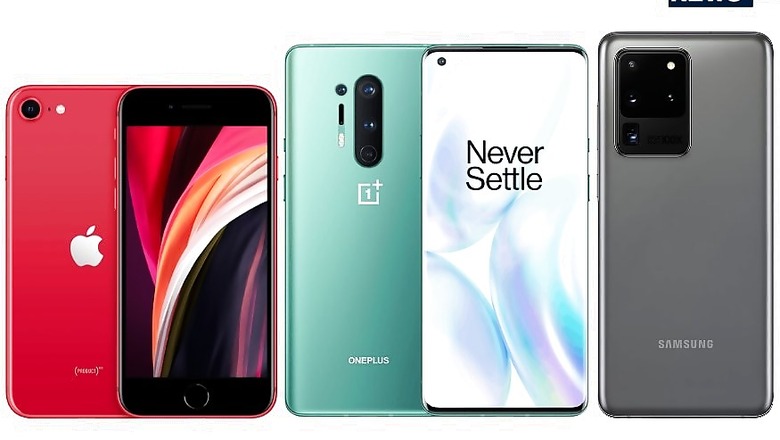
views
If someone was to ask you, let us say on April 14, about the best compact phones to buy, which ones would you recommend? One would suspect, you would talk about the Apple iPhone 11 Pro (which has a 5.8-inch display), the Google Pixel 4 (5.7-inch), maybe even the Samsung Galaxy S10e (5.8-inch). This new definition of a compact phone is a far cry from the days when a 4.5-inch screen size or whereabouts was considered a compact phone. And anything around 5.5-inches or larger was the big screen phone for those who preferred as much. That is perhaps why the Apple iPhone SE second-generation makes a lot of sense, because it takes us back to a time when the very definition of compact phones wasn’t subjective. With a 4.7-inch display that takes us back to the era of the iPhone 8 (that seems like a distant memory, mind you, as time flies), a phone that fits snugly in your hand is very much a reality again.
There is a reason why Apple has stuck with the 4.7-inch display size. And not the larger 5.5-inch screen which was perhaps also an option, if explored. Apple has kept one 4.7-inch size iPhone since the iPhone 6. The iPhone 6s, the iPhone 7 and the iPhone 8 followed. Apple has reportedly sold as many as 500 million phones of this screen size over the years, which means these four phones remained quite popular. In fact, the iPhone 8 was on sale in many parts of the world, including in stores in India, till the iPhone SE second generation arrived.
But it hasn’t always been big screen phones.
It may perhaps be a wrong fit to talk about the days of the Blackberry and Palm phones with their 2.5-inch displays because they also had physical QWERTY keyboards to go along. Or even the Nokia N-series, very popular at one time. The winds of change blew in when Apple announced the very first iPhone which arrived in 2007 with a 3.5-inch display. An all-display, touchscreen phone that didn’t have a physical keyboard. That changed the game, in terms of how users approached smartphones.
But not everyone was happy. An internal Samsung document back in 2008, published then by the good folks over at AppleInsider suggested that some users complained the iPhone and the iPhone 3G (which also had the same screen size), were too big. That document refers to a London based customer saying that it is “quite monstrously large.” Another user, this time in Singapore mentioned, “I prefer something that can fit into a ladies’ bag, but the iPhone is too big, it will bulge out.”
Think about how user preferences have changed over the years. Or have they been forced to? A 3.5-inch phone was monstrously large then, and we are regularly seeing new phones have anywhere between 6-inch to 7-inch display sizes. In that backdrop, a 4.5-inch display seems quite compact. It took competitors a while, but they started responding. By 2010, Android had evolved to version 2.0 and phone makers started going big with screens. The Samsung Galaxy S, the point from which the successful journey started, launched with a 4-inch display. Larger than the iPhone 3GS and the iPhone 4, which had 3.5-inch screen sizes. In the coming years, the likes of the HTC Sensation (4.3-inch), HTC Sensation XL (4.7-inch), Samsung Galaxy S2 (4.5-inch) and the first Samsung Galaxy Note (5.3-inch) followed.
It didn’t take long for the “phablet” category of phones to take shape. While Apple went to a 4-inch display for the iPhone 5 in 2012, Android phones were taking a different path. Samsung’s popular Galaxy S4 came with a 5-inch display, the Galaxy Note 3 had a 5.7-inch display and Nokia, recovering from its debacle of not having made a full-touch phone before Apple was making its presence felt with the 6.4-inch Lumia 1520. It was finally in 2014 that Apple acknowledged this change with the first “Plus” phone—the iPhone 6 Plus with a 5.5-inch display and that accompanied the iPhone 6 and its 4.7-inch display. And that has carried on, till today. So much so that we even stopped noticing the change anymore. More screen for your money worked well for games, watching videos and browsing Facebook. Great, then!
And as we try to figure out what is wrong with the world in the year 2020, smartphones are larger than ever before. Not that large screen phones have anything to do with it. The biggest iPhone at this time is the iPhone 11 Pro Max with a 6.5-inch Super Retina display. At the same time, we have the Samsung Galaxy S20 Ultra with a 6.9-inch display, the Huawei P40 Pro+ (6.58-inch), the OnePlus 8 Pro (6.78-inch) and the Xiaomi Redmi K30 Pro (6.67-inch) to name a few. This is why the Apple iPhone SE second generation, and its 4.7-inch display, can safely claim to be a compact alternative in case you want a phone that fits in your bag. Or trouser pocket. Easily. It doesn’t compromise on performance or experience, while costing much lesser than other iPhones, all of which is priceless.
There are reasons why this change has happened. And a lot of the responsibility lies at our doorstep. The phone, for many, has become the second screen which either complements the PC or effectively replaces it for a large chunk of the time. That means, you need good amount of real estate to work on spreadsheets, emails, and documents. At the same time, our media consumption has also shifted towards phones, quite significantly. Plus, games, we are reading more on phones, video chatting has evolved to video meetings and apps in general want to push a lot more information on the same screen than ever before. We want battery guzzling 4G and we want all sorts of apps syncing and updating at all times. This necessitates larger battery capacity (compact batteries won’t really cut it in such an intense usage scenario), and physically, that can only be done when the battery packs go larger. That means phone enclosures become larger, and bigger screens join the party as a result. Phone makers have softened the blow by slimming down the bezels considerably.
The era of big screen phones is very much here to stay. Mind you. And personally, I am delighted. But it is always good to have genuinely capable more compact smartphones available for those who prefer good things in small packages.



















Comments
0 comment